Health, Safety, and Security in Health and Social Care - Report
VerifiedAdded on 2020/06/04
|6
|1372
|50
Report
AI Summary
This report delves into the critical aspects of health, safety, and security within health and social care environments. It begins by identifying potential hazards, categorized into physical, equipment-related, and infection-related risks, that can affect patients, staff, and visitors. The report then explores relevant legislation, including the Health and Safety at Work Act and General Food Hygiene regulations, emphasizing their role in minimizing dangers. A detailed overview of risk assessment in health and social care settings is provided, outlining the stages of hazard identification, impact assessment, risk evaluation, and action planning. Finally, the report discusses priorities and responses to emergencies, such as fires and accidents, underscoring the importance of quick reactions and adherence to established protocols to mitigate risks and ensure safety. The report concludes by highlighting the importance of following legal guidelines and implementing safety measures to improve the well-being of individuals in health and care centers.
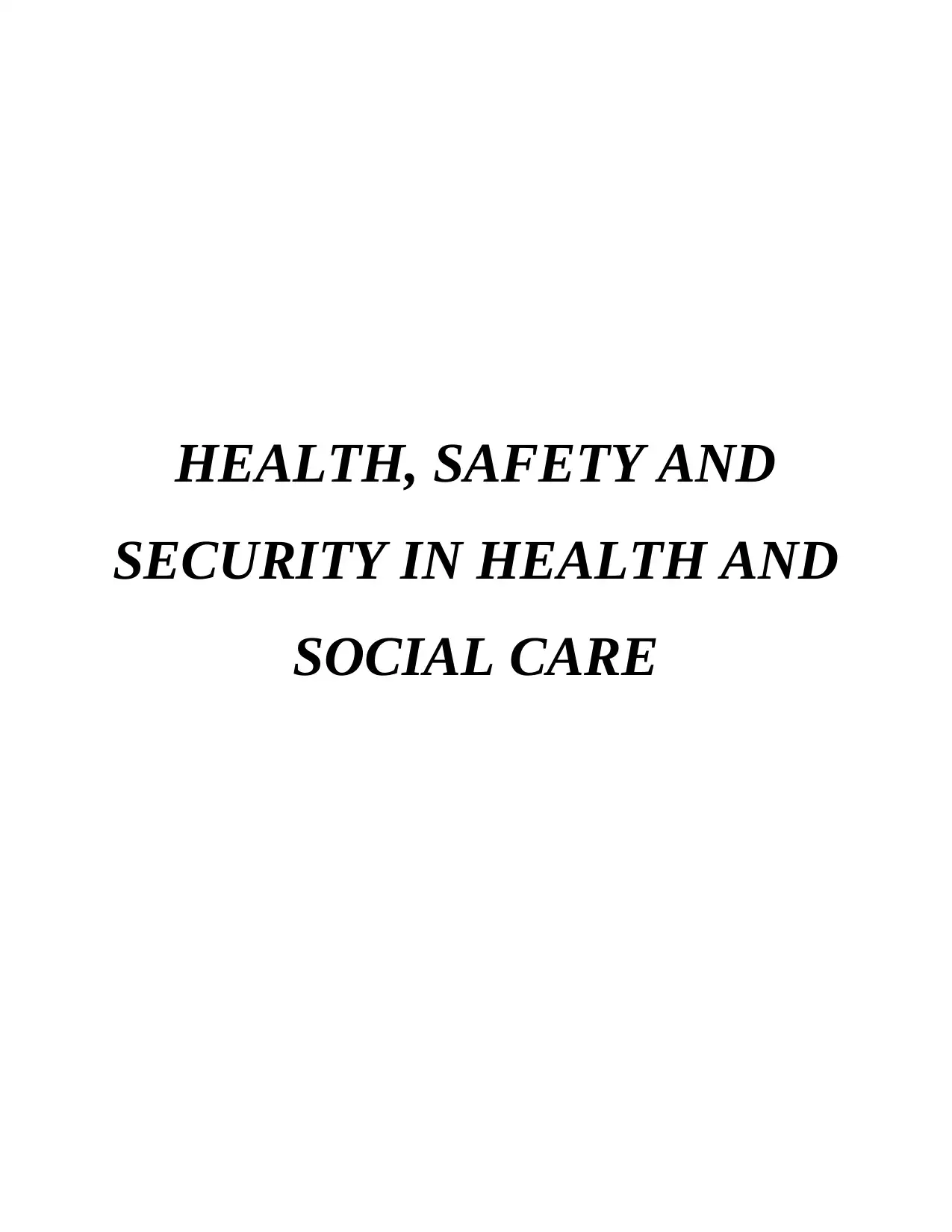
HEALTH, SAFETY AND
SECURITY IN HEALTH AND
SOCIAL CARE
SECURITY IN HEALTH AND
SOCIAL CARE
Paraphrase This Document
Need a fresh take? Get an instant paraphrase of this document with our AI Paraphraser
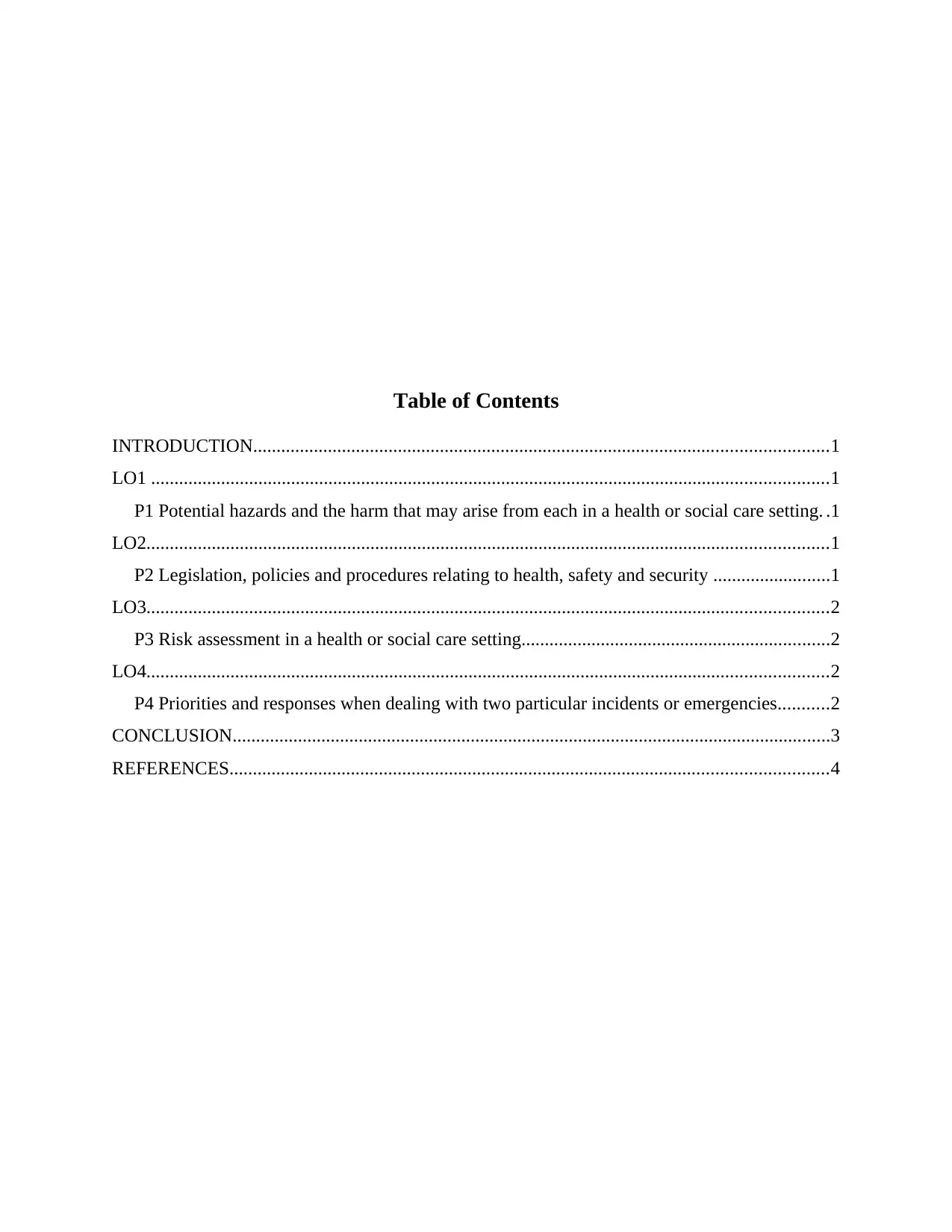
Table of Contents
INTRODUCTION...........................................................................................................................1
LO1 .................................................................................................................................................1
P1 Potential hazards and the harm that may arise from each in a health or social care setting. .1
LO2..................................................................................................................................................1
P2 Legislation, policies and procedures relating to health, safety and security .........................1
LO3..................................................................................................................................................2
P3 Risk assessment in a health or social care setting..................................................................2
LO4..................................................................................................................................................2
P4 Priorities and responses when dealing with two particular incidents or emergencies...........2
CONCLUSION................................................................................................................................3
REFERENCES................................................................................................................................4
INTRODUCTION...........................................................................................................................1
LO1 .................................................................................................................................................1
P1 Potential hazards and the harm that may arise from each in a health or social care setting. .1
LO2..................................................................................................................................................1
P2 Legislation, policies and procedures relating to health, safety and security .........................1
LO3..................................................................................................................................................2
P3 Risk assessment in a health or social care setting..................................................................2
LO4..................................................................................................................................................2
P4 Priorities and responses when dealing with two particular incidents or emergencies...........2
CONCLUSION................................................................................................................................3
REFERENCES................................................................................................................................4
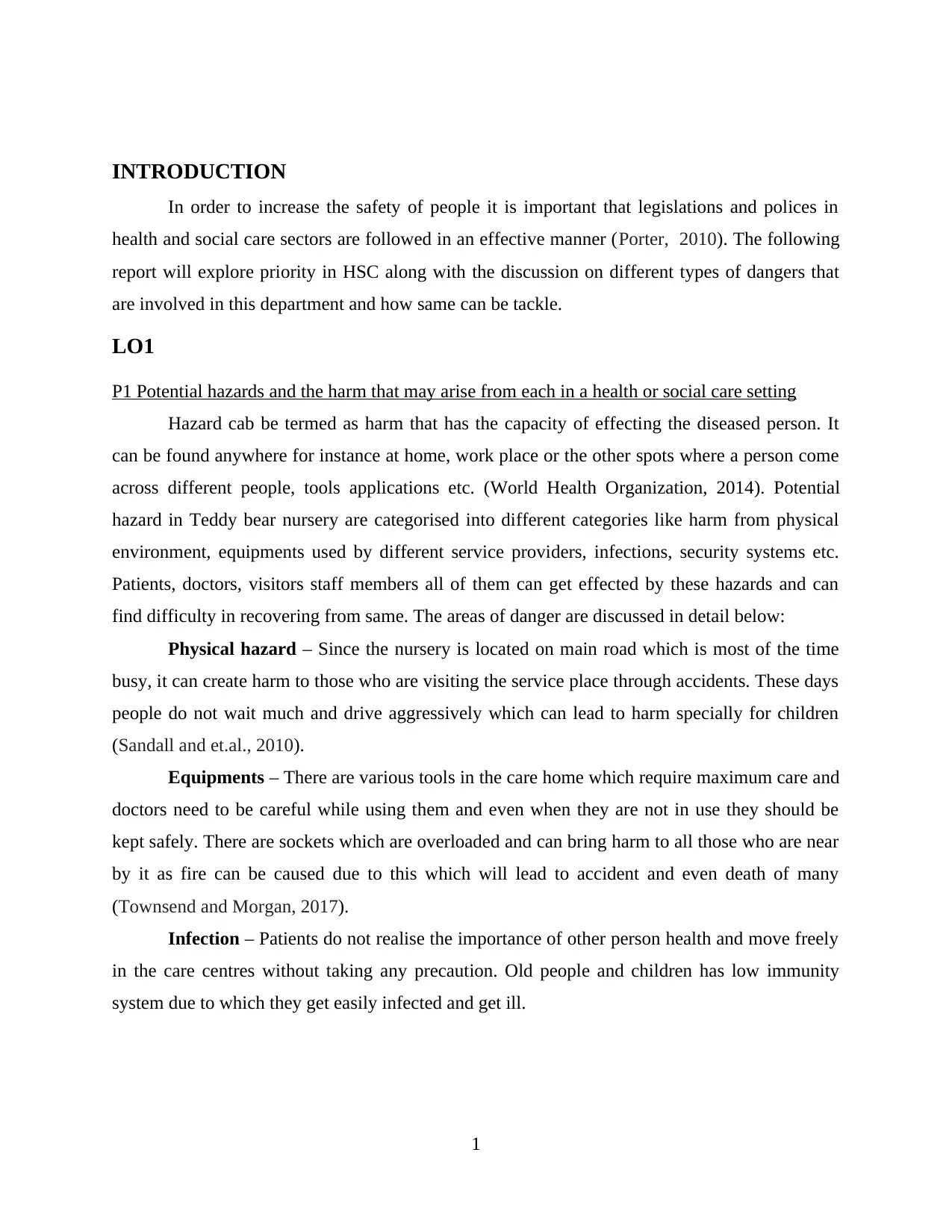
INTRODUCTION
In order to increase the safety of people it is important that legislations and polices in
health and social care sectors are followed in an effective manner (Porter, 2010). The following
report will explore priority in HSC along with the discussion on different types of dangers that
are involved in this department and how same can be tackle.
LO1
P1 Potential hazards and the harm that may arise from each in a health or social care setting
Hazard cab be termed as harm that has the capacity of effecting the diseased person. It
can be found anywhere for instance at home, work place or the other spots where a person come
across different people, tools applications etc. (World Health Organization, 2014). Potential
hazard in Teddy bear nursery are categorised into different categories like harm from physical
environment, equipments used by different service providers, infections, security systems etc.
Patients, doctors, visitors staff members all of them can get effected by these hazards and can
find difficulty in recovering from same. The areas of danger are discussed in detail below:
Physical hazard – Since the nursery is located on main road which is most of the time
busy, it can create harm to those who are visiting the service place through accidents. These days
people do not wait much and drive aggressively which can lead to harm specially for children
(Sandall and et.al., 2010).
Equipments – There are various tools in the care home which require maximum care and
doctors need to be careful while using them and even when they are not in use they should be
kept safely. There are sockets which are overloaded and can bring harm to all those who are near
by it as fire can be caused due to this which will lead to accident and even death of many
(Townsend and Morgan, 2017).
Infection – Patients do not realise the importance of other person health and move freely
in the care centres without taking any precaution. Old people and children has low immunity
system due to which they get easily infected and get ill.
1
In order to increase the safety of people it is important that legislations and polices in
health and social care sectors are followed in an effective manner (Porter, 2010). The following
report will explore priority in HSC along with the discussion on different types of dangers that
are involved in this department and how same can be tackle.
LO1
P1 Potential hazards and the harm that may arise from each in a health or social care setting
Hazard cab be termed as harm that has the capacity of effecting the diseased person. It
can be found anywhere for instance at home, work place or the other spots where a person come
across different people, tools applications etc. (World Health Organization, 2014). Potential
hazard in Teddy bear nursery are categorised into different categories like harm from physical
environment, equipments used by different service providers, infections, security systems etc.
Patients, doctors, visitors staff members all of them can get effected by these hazards and can
find difficulty in recovering from same. The areas of danger are discussed in detail below:
Physical hazard – Since the nursery is located on main road which is most of the time
busy, it can create harm to those who are visiting the service place through accidents. These days
people do not wait much and drive aggressively which can lead to harm specially for children
(Sandall and et.al., 2010).
Equipments – There are various tools in the care home which require maximum care and
doctors need to be careful while using them and even when they are not in use they should be
kept safely. There are sockets which are overloaded and can bring harm to all those who are near
by it as fire can be caused due to this which will lead to accident and even death of many
(Townsend and Morgan, 2017).
Infection – Patients do not realise the importance of other person health and move freely
in the care centres without taking any precaution. Old people and children has low immunity
system due to which they get easily infected and get ill.
1
⊘ This is a preview!⊘
Do you want full access?
Subscribe today to unlock all pages.

Trusted by 1+ million students worldwide
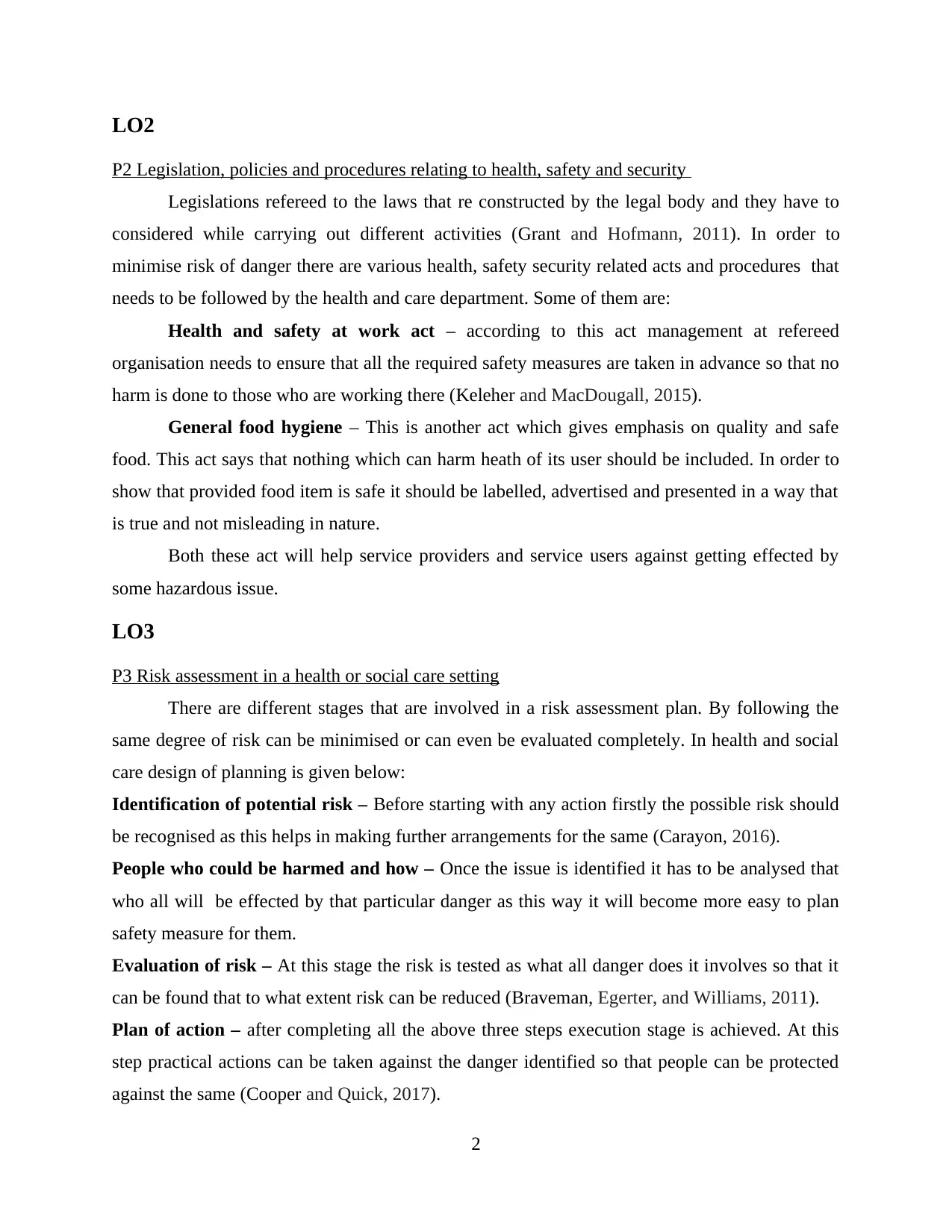
LO2
P2 Legislation, policies and procedures relating to health, safety and security
Legislations refereed to the laws that re constructed by the legal body and they have to
considered while carrying out different activities (Grant and Hofmann, 2011). In order to
minimise risk of danger there are various health, safety security related acts and procedures that
needs to be followed by the health and care department. Some of them are:
Health and safety at work act – according to this act management at refereed
organisation needs to ensure that all the required safety measures are taken in advance so that no
harm is done to those who are working there (Keleher and MacDougall, 2015).
General food hygiene – This is another act which gives emphasis on quality and safe
food. This act says that nothing which can harm heath of its user should be included. In order to
show that provided food item is safe it should be labelled, advertised and presented in a way that
is true and not misleading in nature.
Both these act will help service providers and service users against getting effected by
some hazardous issue.
LO3
P3 Risk assessment in a health or social care setting
There are different stages that are involved in a risk assessment plan. By following the
same degree of risk can be minimised or can even be evaluated completely. In health and social
care design of planning is given below:
Identification of potential risk – Before starting with any action firstly the possible risk should
be recognised as this helps in making further arrangements for the same (Carayon, 2016).
People who could be harmed and how – Once the issue is identified it has to be analysed that
who all will be effected by that particular danger as this way it will become more easy to plan
safety measure for them.
Evaluation of risk – At this stage the risk is tested as what all danger does it involves so that it
can be found that to what extent risk can be reduced (Braveman, Egerter, and Williams, 2011).
Plan of action – after completing all the above three steps execution stage is achieved. At this
step practical actions can be taken against the danger identified so that people can be protected
against the same (Cooper and Quick, 2017).
2
P2 Legislation, policies and procedures relating to health, safety and security
Legislations refereed to the laws that re constructed by the legal body and they have to
considered while carrying out different activities (Grant and Hofmann, 2011). In order to
minimise risk of danger there are various health, safety security related acts and procedures that
needs to be followed by the health and care department. Some of them are:
Health and safety at work act – according to this act management at refereed
organisation needs to ensure that all the required safety measures are taken in advance so that no
harm is done to those who are working there (Keleher and MacDougall, 2015).
General food hygiene – This is another act which gives emphasis on quality and safe
food. This act says that nothing which can harm heath of its user should be included. In order to
show that provided food item is safe it should be labelled, advertised and presented in a way that
is true and not misleading in nature.
Both these act will help service providers and service users against getting effected by
some hazardous issue.
LO3
P3 Risk assessment in a health or social care setting
There are different stages that are involved in a risk assessment plan. By following the
same degree of risk can be minimised or can even be evaluated completely. In health and social
care design of planning is given below:
Identification of potential risk – Before starting with any action firstly the possible risk should
be recognised as this helps in making further arrangements for the same (Carayon, 2016).
People who could be harmed and how – Once the issue is identified it has to be analysed that
who all will be effected by that particular danger as this way it will become more easy to plan
safety measure for them.
Evaluation of risk – At this stage the risk is tested as what all danger does it involves so that it
can be found that to what extent risk can be reduced (Braveman, Egerter, and Williams, 2011).
Plan of action – after completing all the above three steps execution stage is achieved. At this
step practical actions can be taken against the danger identified so that people can be protected
against the same (Cooper and Quick, 2017).
2
Paraphrase This Document
Need a fresh take? Get an instant paraphrase of this document with our AI Paraphraser
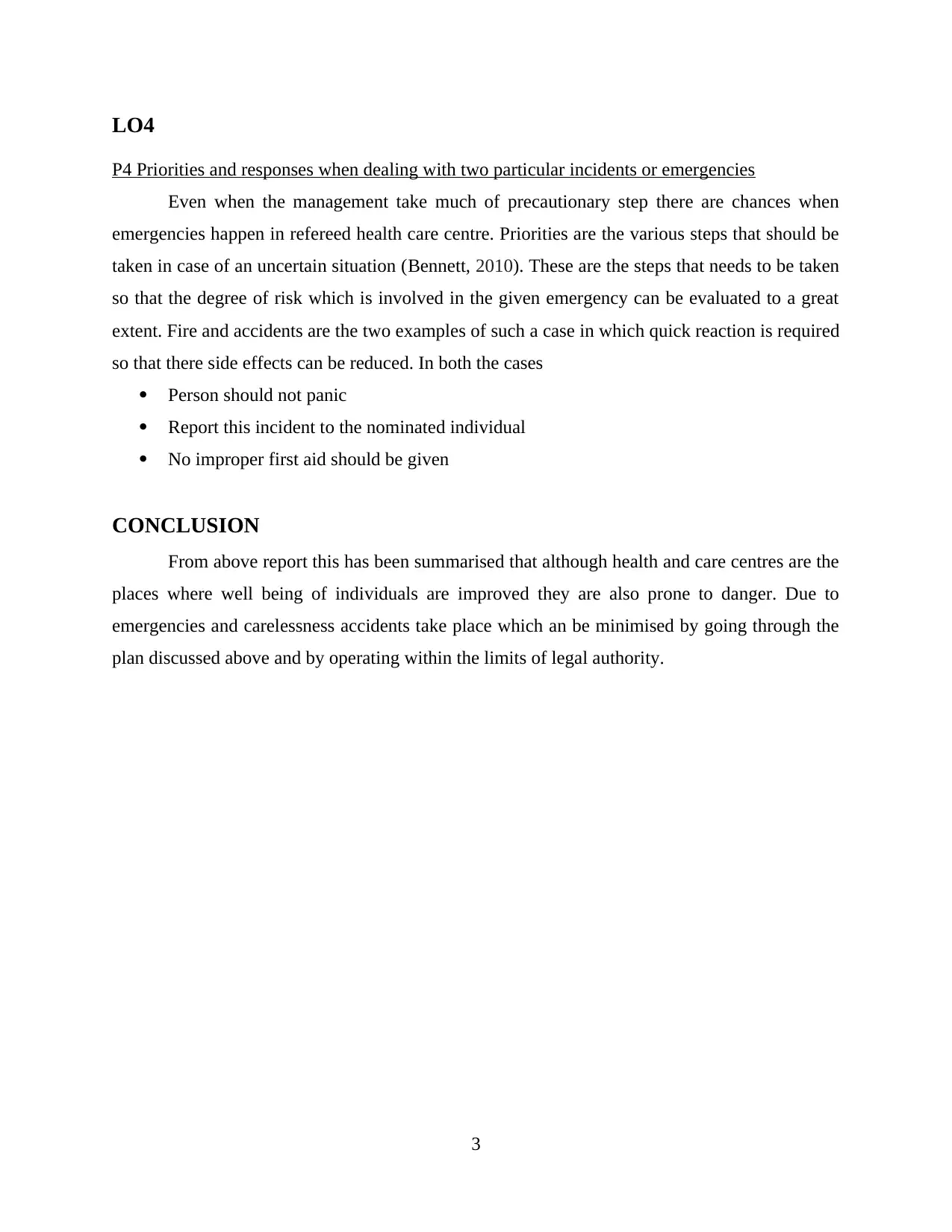
LO4
P4 Priorities and responses when dealing with two particular incidents or emergencies
Even when the management take much of precautionary step there are chances when
emergencies happen in refereed health care centre. Priorities are the various steps that should be
taken in case of an uncertain situation (Bennett, 2010). These are the steps that needs to be taken
so that the degree of risk which is involved in the given emergency can be evaluated to a great
extent. Fire and accidents are the two examples of such a case in which quick reaction is required
so that there side effects can be reduced. In both the cases
Person should not panic
Report this incident to the nominated individual
No improper first aid should be given
CONCLUSION
From above report this has been summarised that although health and care centres are the
places where well being of individuals are improved they are also prone to danger. Due to
emergencies and carelessness accidents take place which an be minimised by going through the
plan discussed above and by operating within the limits of legal authority.
3
P4 Priorities and responses when dealing with two particular incidents or emergencies
Even when the management take much of precautionary step there are chances when
emergencies happen in refereed health care centre. Priorities are the various steps that should be
taken in case of an uncertain situation (Bennett, 2010). These are the steps that needs to be taken
so that the degree of risk which is involved in the given emergency can be evaluated to a great
extent. Fire and accidents are the two examples of such a case in which quick reaction is required
so that there side effects can be reduced. In both the cases
Person should not panic
Report this incident to the nominated individual
No improper first aid should be given
CONCLUSION
From above report this has been summarised that although health and care centres are the
places where well being of individuals are improved they are also prone to danger. Due to
emergencies and carelessness accidents take place which an be minimised by going through the
plan discussed above and by operating within the limits of legal authority.
3
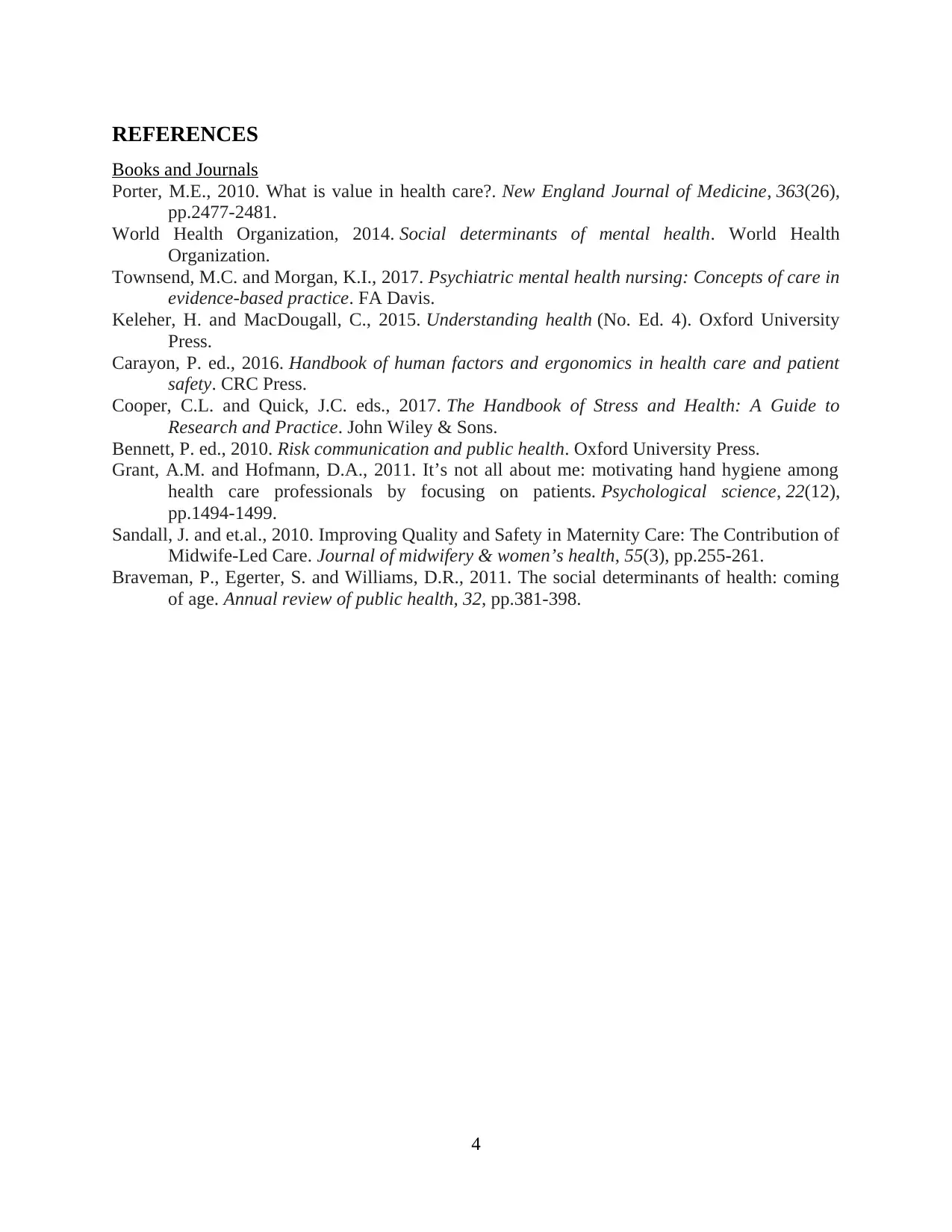
REFERENCES
Books and Journals
Porter, M.E., 2010. What is value in health care?. New England Journal of Medicine, 363(26),
pp.2477-2481.
World Health Organization, 2014. Social determinants of mental health. World Health
Organization.
Townsend, M.C. and Morgan, K.I., 2017. Psychiatric mental health nursing: Concepts of care in
evidence-based practice. FA Davis.
Keleher, H. and MacDougall, C., 2015. Understanding health (No. Ed. 4). Oxford University
Press.
Carayon, P. ed., 2016. Handbook of human factors and ergonomics in health care and patient
safety. CRC Press.
Cooper, C.L. and Quick, J.C. eds., 2017. The Handbook of Stress and Health: A Guide to
Research and Practice. John Wiley & Sons.
Bennett, P. ed., 2010. Risk communication and public health. Oxford University Press.
Grant, A.M. and Hofmann, D.A., 2011. It’s not all about me: motivating hand hygiene among
health care professionals by focusing on patients. Psychological science, 22(12),
pp.1494-1499.
Sandall, J. and et.al., 2010. Improving Quality and Safety in Maternity Care: The Contribution of
Midwife‐Led Care. Journal of midwifery & women’s health, 55(3), pp.255-261.
Braveman, P., Egerter, S. and Williams, D.R., 2011. The social determinants of health: coming
of age. Annual review of public health, 32, pp.381-398.
4
Books and Journals
Porter, M.E., 2010. What is value in health care?. New England Journal of Medicine, 363(26),
pp.2477-2481.
World Health Organization, 2014. Social determinants of mental health. World Health
Organization.
Townsend, M.C. and Morgan, K.I., 2017. Psychiatric mental health nursing: Concepts of care in
evidence-based practice. FA Davis.
Keleher, H. and MacDougall, C., 2015. Understanding health (No. Ed. 4). Oxford University
Press.
Carayon, P. ed., 2016. Handbook of human factors and ergonomics in health care and patient
safety. CRC Press.
Cooper, C.L. and Quick, J.C. eds., 2017. The Handbook of Stress and Health: A Guide to
Research and Practice. John Wiley & Sons.
Bennett, P. ed., 2010. Risk communication and public health. Oxford University Press.
Grant, A.M. and Hofmann, D.A., 2011. It’s not all about me: motivating hand hygiene among
health care professionals by focusing on patients. Psychological science, 22(12),
pp.1494-1499.
Sandall, J. and et.al., 2010. Improving Quality and Safety in Maternity Care: The Contribution of
Midwife‐Led Care. Journal of midwifery & women’s health, 55(3), pp.255-261.
Braveman, P., Egerter, S. and Williams, D.R., 2011. The social determinants of health: coming
of age. Annual review of public health, 32, pp.381-398.
4
⊘ This is a preview!⊘
Do you want full access?
Subscribe today to unlock all pages.

Trusted by 1+ million students worldwide
1 out of 6
Related Documents
Your All-in-One AI-Powered Toolkit for Academic Success.
+13062052269
info@desklib.com
Available 24*7 on WhatsApp / Email
![[object Object]](/_next/static/media/star-bottom.7253800d.svg)
Unlock your academic potential
Copyright © 2020–2025 A2Z Services. All Rights Reserved. Developed and managed by ZUCOL.





